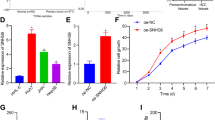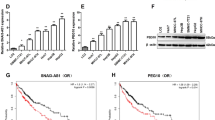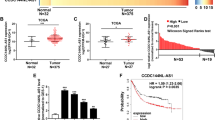Abstract
The expression of long non-coding RNAs (lncRNAs) is dysregulated in hepatocellular carcinoma (HCC). However, the functions and contributions of lncRNAs remain largely unknown. Here, we identified a critical role of SNHG6-003 in HCC. We found that five SNHG6 transcripts were differentially expressed in HCC tissues while only the SNHG6-003 had an oncogenic function. Ectopic expression of SNHG6-003 in HCC cells promoted cell proliferation and induced drug resistance, whereas SNHG6-003 knockdown promoted apoptosis. Moreover, SNHG6-003 functioned as a competitive endogenous RNA (ceRNA), effectively becoming sponge for miR-26a/b and thereby modulating the expression of transforming growth factor-β-activated kinase 1 (TAK1). Importantly, expression analysis revealed that both SNHG6-003 and TAK1 were upregulated in human cancers, exhibiting a co-expression pattern. In HCC patients, high expression of SNHG6-003 closely correlated with tumor progression and shorter survival. Thus, targeting the ceRNA network involving SNHG6-003 may be used as a treatment strategy against HCC.
This is a preview of subscription content, access via your institution
Access options
Subscribe to this journal
Receive 50 print issues and online access
$259.00 per year
only $5.18 per issue
Buy this article
- Purchase on Springer Link
- Instant access to full article PDF
Prices may be subject to local taxes which are calculated during checkout







Similar content being viewed by others
References
Torre LA, Bray F, Siegel RL, Ferlay J, Lortet-Tieulent J, Jemal A . Global cancer statistics, 2012. CA Cancer J Clin 2015; 65: 87–108.
Bodzin AS, Busuttil RW . Hepatocellular carcinoma: advances in diagnosis, management, and long term outcome. World J Hepatol 2015; 7: 1157–1167.
Wang P, Ning S, Zhang Y, Li R, Ye J, Zhao Z et al. Identification of lncRNA-associated competing triplets reveals global patterns and prognostic markers for cancer. Nucleic Acids Res 2015; 43: 3478–3489.
Liu B, Sun L, Liu Q, Gong C, Yao Y, Lv X et al. A cytoplasmic NF-kappaB interacting long noncoding RNA blocks IkappaB phosphorylation and suppresses breast cancer metastasis. Cancer Cell 2015; 27: 370–381.
Yuan JH, Yang F, Wang F, Ma JZ, Guo YJ, Tao QF et al. A long noncoding RNA activated by TGF-beta promotes the invasion-metastasis cascade in hepatocellular carcinoma. Cancer Cell 2014; 25: 666–681.
Cao C, Sun J, Zhang D, Guo X, Xie L, Li X et al. The long intergenic noncoding RNA UFC1, a target of microRNA 34a, interacts with the mRNA stabilizing protein HuR to increase levels of beta-catenin in HCC cells. Gastroenterology 2015; 148: e418.
Tay Y, Rinn J, Pandolfi PP . The multilayered complexity of ceRNA crosstalk and competition. Nature 2014; 505: 344–352.
Kumar MS, Armenteros-Monterroso E, East P, Chakravorty P, Matthews N, Winslow MM et al. HMGA2 functions as a competing endogenous RNA to promote lung cancer progression. Nature 2014; 505: 212–217.
Karreth FA, Reschke M, Ruocco A, Ng C, Chapuy B, Leopold V et al. The BRAF pseudogene functions as a competitive endogenous RNA and induces lymphoma in vivo. Cell 2015; 161: 319–332.
Hansen TB, Jensen TI, Clausen BH, Bramsen JB, Finsen B, Damgaard CK et al. Natural RNA circles function as efficient microRNA sponges. Nature 2013; 495: 384–388.
Liu XH, Sun M, Nie FQ, Ge YB, Zhang EB, Yin DD et al. Lnc RNA HOTAIR functions as a competing endogenous RNA to regulate HER2 expression by sponging miR-331-3p in gastric cancer. Mol Cancer 2014; 13: 92.
Tang J, Zhuo H, Zhang X, Jiang R, Ji J, Deng L et al. A novel biomarker Linc00974 interacting with KRT19 promotes proliferation and metastasis in hepatocellular carcinoma. Cell Death Dis 2014; 5: e1549.
Jalali S, Bhartiya D, Lalwani MK, Sivasubbu S, Scaria V . Systematic transcriptome wide analysis of lncRNA-miRNA interactions. PLoS One 2013; 8: e53823.
Ghosal S, Das S, Sen R, Chakrabarti J . HumanViCe: host ceRNA network in virus infected cells in human. Front Genet 2014; 5: 249.
Zhang YC, Liao JY, Li ZY, Yu Y, Zhang JP, Li QF et al. Genome-wide screening and functional analysis identify a large number of long noncoding RNAs involved in the sexual reproduction of rice. Genome Biol 2014; 15: 512.
Zheng L, Li X, Gu Y, Lv X, Xi T . The 3'UTR of the pseudogene CYP4Z2P promotes tumor angiogenesis in breast cancer by acting as a ceRNA for CYP4Z1. Breast Cancer Res Treat 2015; 150: 105–118.
Li L, Wang D, Xue M, Mi X, Liang Y, Wang P . 3'UTR shortening identifies high-risk cancers with targeted dysregulation of the ceRNA network. Sci Rep 2014; 4: 5406.
Liu M, Chen L, Chan TH, Wang J, Li Y, Zeng TT et al. Serum and glucocorticoid kinase 3 at 8q13.1 promotes cell proliferation and survival in hepatocellular carcinoma. Hepatology 2012; 55: 1754–1765.
Zhou X, Gao Q, Wang J, Zhang X, Liu K, Duan Z . Linc-RNA-RoR acts as a "sponge" against mediation of the differentiation of endometrial cancer stem cells by microRNA-145. Gynecol Oncol 2014; 133: 333–339.
Wu X, Zhang W, Font-Burgada J, Palmer T, Hamil AS, Biswas SK et al. Ubiquitin-conjugating enzyme Ubc13 controls breast cancer metastasis through a TAK1-p38 MAP kinase cascade. Proc Natl Acad Sci USA 2014; 111: 13870–13875.
Volders PJ, Helsens K, Wang X, Menten B, Martens L, Gevaert K et al. LNCipedia: a database for annotated human lncRNA transcript sequences and structures. Nucleic Acids Res 2013; 41: D246–D251.
Joo JH, Ryu D, Peng Q, Sugrue SP . Role of Pnn in alternative splicing of a specific subset of lncRNAs of the corneal epithelium. Mol Vis 2014; 20: 1629–1642.
Chen FC, Pan CL, Lin HY . Functional implications of RNA splicing for human long intergenic noncoding RNAs. Evol Bioinform Online 2014; 10: 219–228.
Bak RO, Mikkelsen JG . miRNA sponges: soaking up miRNAs for regulation of gene expression. Wiley Interdiscip Rev RNA 2014; 5: 317–333.
Tay FC, Lim JK, Zhu H, Hin LC, Wang S . Using artificial microRNA sponges to achieve microRNA loss-of-function in cancer cells. Adv Drug Deliv Rev 2015; 81: 117–127.
Cesana M, Cacchiarelli D, Legnini I, Santini T, Sthandier O, Chinappi M et al. A long noncoding RNA controls muscle differentiation by functioning as a competing endogenous RNA. Cell 2011; 147: 358–369.
Ng SY, Bogu GK, Soh BS, Stanton LW . The long noncoding RNA RMST interacts with SOX2 to regulate neurogenesis. Mol Cell 2013; 51: 349–359.
Pilyugin M, Irminger-Finger I . Long non-coding RNA and microRNAs might act in regulating the expression of BARD1 mRNAs. Int J Biochem Cell Biol 2014; 54: 356–367.
Ma MZ, Chu BF, Zhang Y, Weng MZ, Qin YY, Gong W et al. Long non-coding RNA CCAT1 promotes gallbladder cancer development via negative modulation of miRNA-218-5p. Cell Death Dis 2015; 6: e1583.
Hou P, Zhao Y, Li Z, Yao R, Ma M, Gao Y et al. LincRNA-ROR induces epithelial-to-mesenchymal transition and contributes to breast cancer tumorigenesis and metastasis. Cell Death Dis 2014; 5: e1287.
Ge D, Han L, Huang S, Peng N, Wang P, Jiang Z et al. Identification of a novel MTOR activator and discovery of a competing endogenous RNA regulating autophagy in vascular endothelial cells. Autophagy 2014; 10: 957–971.
Cai PC, Shi L, Liu VW, Tang HW, Liu IJ, Leung TH et al. Elevated TAK1 augments tumor growth and metastatic capacities of ovarian cancer cells through activation of NF-kappaB signaling. Oncotarget 2014; 5: 7549–7562.
Chen IT, Hsu PH, Hsu WC, Chen NJ, Tseng PH . Polyubiquitination of transforming growth factor beta-activated kinase 1 (TAK1) at lysine 562 residue regulates TLR4-mediated JNK and p38 MAPK activation. Sci Rep 2015; 5: 12300.
Fan Y, Cheng J, Vasudevan SA, Patel RH, Liang L, Xu X et al. TAK1 inhibitor 5Z-7-oxozeaenol sensitizes neuroblastoma to chemotherapy. Apoptosis 2013; 18: 1224–1234.
Acknowledgements
This work was supported by the National Nature Science Foundation of China (Grant Nos. 81172586, 81401180, 81372283 and 91540111), Guangdong Province Universities and Colleges Pearl River Scholar Funded Scheme (2015), Natural Science Funding of Guangdong Province (Grant No. 2014A030311013) and postdoctoral fellowship from American Heart Association 16POST26400005 (to XL). LX thanks Dr Hang Yin (University of Georgia) for support of the studies proposed in this manuscript.
Author information
Authors and Affiliations
Corresponding authors
Ethics declarations
Competing interests
The authors declare no conflict of interest.
Additional information
Supplementary Information accompanies this paper on the Oncogene website
Supplementary information
Rights and permissions
About this article
Cite this article
Cao, C., Zhang, T., Zhang, D. et al. The long non-coding RNA, SNHG6-003, functions as a competing endogenous RNA to promote the progression of hepatocellular carcinoma. Oncogene 36, 1112–1122 (2017). https://doi.org/10.1038/onc.2016.278
Received:
Revised:
Accepted:
Published:
Issue Date:
DOI: https://doi.org/10.1038/onc.2016.278
This article is cited by
-
Integration of transcription regulation and functional genomic data reveals lncRNA SNHG6’s role in hematopoietic differentiation and leukemia
Journal of Biomedical Science (2024)
-
MARS an improved de novo peptide candidate selection method for non-canonical antigen target discovery in cancer
Nature Communications (2024)
-
LncRNA SNHG6 role in clinicopathological parameters in cancers
European Journal of Medical Research (2023)
-
Spatial transcriptomics reveals niche-specific enrichment and vulnerabilities of radial glial stem-like cells in malignant gliomas
Nature Communications (2023)
-
Long non-coding RNA SNHG6 couples cholesterol sensing with mTORC1 activation in hepatocellular carcinoma
Nature Metabolism (2022)



